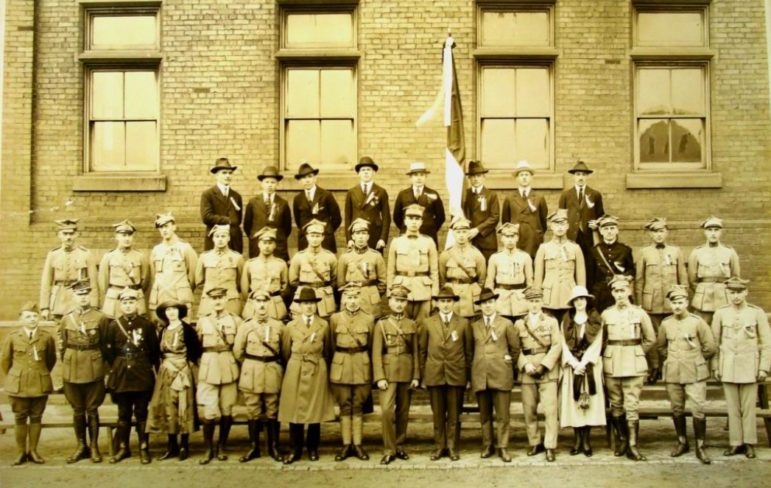
Polish Army Veterans Association of America Archives
Founding fathers of the Polish Army Veterans Association of America, pictured here in May 1921 in Cleveland, OH.
Read the original story in Polish at Nowy Dziennik
Celebrating the centennial of the recruitment of Polish immigrants from the United States to the Polish Army in France during World War I, New York’s division of the Polish Army Veterans Association of America (PAVA) is making an effort to keep the memory of these volunteer freedom fighters alive.
“If it wasn’t for the volunteer fighters from the U.S., the Polish Army in France wouldn’t have formed during [World War I] and Poland wouldn’t have had its representation at the peace conference in Paris in 1919,” says Teofil Lachowicz, an expert on volunteer fighters from the United States during WWI and an archivist at the PAVA museum, which is located on Irving Place in Manhattan.
“Unfortunately history books devote hardly any attention to the brave patriots, and even historians in Poland don’t know much about these heroes. We are doing our best to keep their memory alive,” he adds.
Immigrants from Poland who arrived in the United States at the turn of the 20th Century came here in pursuit of peace, work and stabilization. However, they never ceased thinking about the motherland they left behind and sought ways of helping their home country regain independence.

Voices of New York spotlights ethnic and community reporting from around the city. Click here to read more.
On Oct. 6, 1917, the U.S. government allowed for the recruitment of volunteers to the Polish Army, and Polish immigrants in the U.S., mainly on the East Coast, had already been gearing up for such a moment — since 1912, the Polish Falcons of America had been providing military training to such volunteers.
In October 1917, recruitment began in 47 of the biggest Polish-immigrant communities in the U.S. During a year and a half, over 22,000 men qualified for training held in Niagara-on-the-Lake, Canada, and then came to New York to board ships to France.
The first group from the U.S. arrived on French soil in December of 1918. Even though the Polish Army in France was meant for Polish volunteers from all over the world, it was Poles from the states who constituted the core of the group. This military formation was called the Blue Army, named after the color of the men’s uniforms, and volunteers from the U.S. could be recognized by a metal eagle on their soldiers’ hats. The eagle, manufactured in Jersey City, NJ, has now become a symbol of the heroic fight led by America’s Polish immigrants for Poland’s independence during the war.
Of the more than 22,000 volunteers who joined the Blue Army, 1,832 died in battle. Some volunteer fighters stayed in Poland after the war, and an estimated 12,500 to 14,000 returned to the U.S., where in 1921 they formed PAVA.
PAVA has led an effort to preserve the memory of these Polish-American freedom fighters: The organization has sponsored a monument in Warsaw and a commemorative plaque in the Polish-American National Shrine of Our Lady of Czestochowa in Doylestown, PA. PAVA’s District 2, based in New York, also restored one of the fighter’s graves in the western part of Poland, and eagerly welcomes delegations from Poland at their museum, located at the Veterans’ Home on Irving Place.
PAVA’s commemoration of the centennial of the freedom fighters’ efforts continues this year. The group has sponsored a number of publications on the history of the Blue Army, including “Sons of One Nation: The War Effort of the Polish Emigration in America 1914-1920,” which was mailed to more than 100 university libraries in the U.S. and Canada.
“No other Polish American organization has done something like that. That’s the best monument for the volunteer fighters,” says Lachowicz.
The organization has also issued a commemorative medal featuring the legendary eagle, the first copy of which was given to Poland’s president Andrzej Duda during his visit to New York in 2017.
PAVA cosponsors exhibitions and events promoting the history of the Blue Army in both the U.S. and Poland, while Lachowicz has given a number of speeches about the heroes, whom he has devoted the last 30 years of his career.
“We won’t stop. We will keep on trying to break the glass ceiling and continue spreading the word about our Polish-American heroes,” he says.









One thought on “Veterans Group Marks 100-Year Milestone for WWI’s Polish-American Freedom Fighters”
Pingback: Veterans Group Marks 100-Year Milestone for WWI's Polish-American Freedom Fighters – City Limits – Of The Peace Foundation